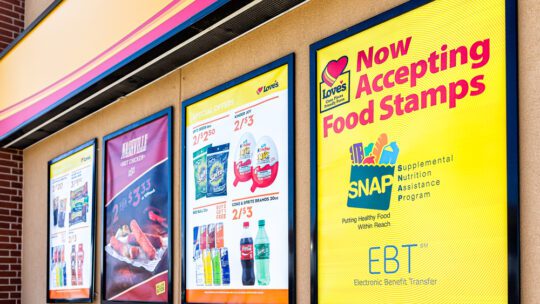
This week's PR Roundup explores how brands should approach SNAP and the government shutdown, Muck Rack's latest "State of PR Measurement" report and a beefy campaign from A.1.
SNAP Back: Brands Step Up Amid Shutdown Confusion
What happened: As the government shutdown stretches on, confusion around SNAP benefits has led to a wave of misinformation, but also meaningful action. After fake social posts circulated this week claiming national restaurant chains like Red Lobster, Olive Garden and Popeyes were offering free food to SNAP recipients, Newsweek debunked these claims.
However, while no nationwide programs exist, local businesses across the country are stepping in to help. Restaurants in Chicago, Massachusetts, Atlanta, Maine and other areas are providing free or discounted meals to those impacted by delayed benefits and furloughed federal workers.
In Washington, D.C., José Andrés’s restaurants and World Central Kitchen have opened community kitchens to serve free meals to federal employees and families hit hardest by the stalemate. Meanwhile, Instacart is continuing its own SNAP support initiatives for food banks— despite a USDA warning reminding retailers they cannot offer direct discounts to SNAP participants.
Communication takeaways: The moment highlights how food brands and local restaurants are filling a gap while federal programs pause, showing both compassion and communication savvy. How brands respond in times of uncertainty—especially when policy and public need collide— can define their reputation and strengthen community trust.
Hinda Mitchell, President at Inspire PR, says that brands can help while avoiding stepping into the political deep end.
“While SNAP can be a divisive issue—hunger relief is a safe space for brands,” Mitchell says. “For example, instead of talking about the shutdown, talk about the disruption of food benefits. Point to examples of how your brand has supported hunger relief efforts in the past, if applicable, and be proactive in sharing any brand-specific responses you have planned.”
When it comes to those fake announcements from “brands” for free items or distribution, Mitchell says to monitor mentions of your brand closely online—and be ready to respond swiftly. But above all, she says brands, especially food brands need to lean into values.
“Connect what your brand stands for (e.g., feeding people, nutrition) to the larger picture of hunger relief,” Mitchell notes.
AI Is Redefining PR Metrics
What happened: November marks PR Measurement Month, and much of this year’s focus is about how AI is reshaping how communicators track success.
According to Muck Rack’s annual “State of PR Measurement” report, released just this week, AI is quickly becoming part of the measurement toolkit—with 61% of PR pros already tracking or planning to track AI-generated mentions, and 93% saying AI will influence how they measure results. Meanwhile, 67% believe visibility within large language models (LLMs) will soon be a key PR metric.
The report also found that while 81% of PR professionals measure their work, a majority still aren’t using formal frameworks like the Barcelona Principles or AMEC’s Integrated Evaluation Framework—a timely reminder, as the PR Council’s “Do You Barcelona?” quiz challenges pros to test their measurement IQ this month.
Key takeaways:
-
AI is rapidly changing the way PR results are tracked and understood.
-
Most pros use media monitoring (85%) and analytics tools (66%), with 15% experimenting with AI analytics.
-
“Stories placed” (86%) and reach/impressions (79%) remain top metrics—though only half of pros actually trust impressions.
-
75% link results to business goals, but connecting those outcomes remains the biggest hurdle.
Communication takeaways: PR pros are measuring more, but not always measuring smarter—making November the perfect time to revisit frameworks and refine strategy.
Greg Galant, Co-founder and CEO of Muck Rack, says the biggest shift from 2024 is seeing how quickly AI has entered the PR measurement conversation.
"Just a year ago, most professionals weren’t thinking much about how large language models (LLMs) might impact visibility,” Galant says. “Now, it’s widely understood that AI is actively reshaping what audiences see. Communicators need to watch closely how their earned media shows up in AI-generated results—it’s fast becoming a new layer of influence, as important as traditional coverage.”
Galant also notes the importance of owned content for communicators.
“We’re also starting to see early signs that owned content could play a larger role in LLM visibility, which is something every communicator should be paying attention to."
Prime Timing: A.1.’s New Campaign Parody’s People’s "Sexiest Man Alive"
What happened: A.1. Sauce is serving up a cheeky new campaign just in time for People’s “Sexiest Man Alive” issue — and it’s giving meatloaf a sultry glow-up. The “Beefcake” campaign, created with agency Rethink, reintroduces the comfort food as the “Sexiest Meat Alive.” Launched this week, A.1. leans into humor and nostalgia to make meatloaf craveable again, because, as the brand puts it, “with A.1., it’s not just a meatloaf, it’s a beefcake.”

The playful push includes a faux People digital cover, a two-page magazine spread before the centerfold and a creator lineup celebrating their own “beefcake energy.” Fans can join in by sharing #A1Beefcake creations via social and trying an official recipe at A1Beefcake.com. The saucy stunt builds on A.1.’s recent “AI vs. A1” campaign, proving the brand knows how to keep itself—and America’s beef—boldly relevant.
Communication takeaways: A.1.’s “Beefcake” campaign shows how reframing a classic can reignite love for a timeless brand, providing a fresh approach to nostalgia messaging.
“A.1., like meatloaf, is a classic [product],” says Geoff Baillie, Partner and Group Creative Director at Rethink. “But sometimes you need to recontextualize a classic for people to remember how great it is.”
By tapping into the buzz around People’s “Sexiest Man Alive”—and the beefcakes within, the brand uses humor to give meatloaf a modern twist. Baillie says A.1. reminds audiences that “[meatloaf] just needed a flashy new name—beefcakes.”
Nicole Schuman is Managing Editor at PRNEWS.
